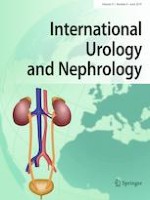Erschienen in:

06.04.2019 | Urology - Original Paper
Prognostic significance of maternal urinary carbohydrate antigen 19-9 for antenatal diagnosis of posterior urethral valve associated with fetal hydronephrosis
verfasst von:
Abdol-Mohammad Kajbafzadeh, Shabnam Sabetkish, Nastaran Sabetkish
Erschienen in:
International Urology and Nephrology
|
Ausgabe 6/2019
Einloggen, um Zugang zu erhalten
Abstract
Purpose
To evaluate the predictive role of maternal urinary CA 19-9 as a non-invasive marker for diagnosing antenatal posterior urethral valve (PUV).
Methods
A total of 40 women in the third pregnancy trimester were enrolled. Case group (group A) consisted of 20 women with a diagnosis of antenatal PUV. Twenty women with similar gestational age, fetal sex, normal US, and no history of congenital anomalies were chosen as a control group (group B). Maternal urine samples were collected and urinary CA 19-9 was measured in both groups. The correlations between maternal urinary CA 19-9 and APD (measured during pregnancy and the initial evaluation of the newborn) were assessed. CA 19-9 level in first urine of neonates was also evaluated.
Results
The mean ± SD of maternal urine CA 19-9 was higher in PUV group compared to the control group (131.6 ± 23.8 vs. 13 ± 2.7 U/mL). In addition, there was a significant correlation between maternal urinary CA 19-9 and the APD measured at the third trimester (p < 0.001) and the initial evaluation of fetus after birth according to SFU grading system (p < 0.001). However, no significant difference was found between gestational age and urinary CA 19-9 level (p = 0.34). There was also a significant correlation between the CA 19-9 level in first urine of neonates and CA 19-9 level of maternal urine (p < 0.001).
Conclusions
This is the first time that maternal urinary CA 19-9 has been applied as a noninvasive and practical diagnostic marker in antenatal PUV.











